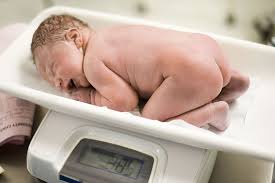
5 Essential Steps for Weighing Your Newborn at Home Safely
5 essential steps for weighing your newborn at home safely, as a parent, welcoming a newborn into the world is an exciting and joyous time. You want to make sure that your baby is healthy and developing, so regular weight monitoring is an important part of newborn care. Pediatrician visits offer professional assessments, but you can also weigh your baby at home in between appointments to gain important insights into their growth. Here are 5 essential steps for weighing your newborn at home safely:

Choose the Correct Scale: The first step in weighing your infant at home is to choose an accurate and trustworthy scale. Invest in a digital baby scale that is made just for babies; these scales are accurate and frequently have features like a cozy platform and an easy-to-read display. Kitchen and toilet scales should not be used on tiny newborns since they could not give reliable readings.
Prepare the Environment: Create a safe and comfortable environment for weighing your newborn at home. Choose a flat and stable surface to place the scale, such as a sturdy table or countertop. Ensure that the room is warm and draft-free to keep your baby comfortable during the process. Keep essential supplies such as diapers and wipes nearby in case your baby needs attention during or after weighing
Create a Routine: When it comes to monitoring your baby’s weight at home, consistency is essential. To keep track your baby’s growth over time, set up a consistent weighing plan, such as once a week or every other week. Select a period when your child is content and has had a meal; this will assist guarantee precise measurements. Steer clear of weighing your infant right away after feeding, since milk consumption may momentarily alter their weight.
Use Correct methodology: Accurate weight measurements of your infant depend on using proper methodology. After turning the scale on and letting it correctly calibrate, place it on a level surface. Your infant should be completely clothed down to their nappy when they are placed gently in the middle of the scale, with their entire body support of the weight that is shown on the scale and make a note of any notable variations from the last measurement.
Track Growth Patterns: Keeping tabs on your infant’s weight increase over time might provide important details about their general growth and well-being. Plot your baby’s weight measurements on a growth chart that your paediatrician or other healthcare practitioner provides to keep track of their development trends. Although small variations in weight are typical, notable departures from the anticipated development curve could necessitate additional assessment by a medical expert.
General tips
- You can use a light blanket for comfort, but remember to set the scales to zero after laying the blanket on the scales
- Ensure you are not leaning on, or touching the scales
- Have a pen and paper ready
- If the infant moves around a lot, try and wait for the scales to stabilize
- Make a note of the date and the weight in kilograms
- Weigh the infant naked
- If you are planning to take regular weights, aim to weigh around the same time of day
- If possible, weigh before a feed or meal
Conclusion
In conclusion, weighing your infant at home can help parents keep track of their child’s development and growth in between trips to the pediatrician. You may make sure that the procedure is carried out correctly and safely by adhering to the five crucial stages that were previously mentioned. Establishing a secure atmosphere holds similar significance. Make sure the setting is safe, warm, and clear of any potential threats before weighing your infant. Not only can a soft towel or blanket make your baby more comfortable, but it also helps to keep the scale clean as you work
Weighing your baby at home on a regular basis gives you the ability as a parent to actively watch their development. Following the five crucial procedures mentioned above will help to guarantee that this procedure is carried out appropriately and safely. Never forget how important it is to communicate openly with your healthcare practitioner. Seek advice and assistance as soon as possible if you have any concerns about your baby’s weight or growth trajectory. Keeping an eye on your baby’s growth at home is crucial for their general development and health, and it lays the groundwork for a bright future.